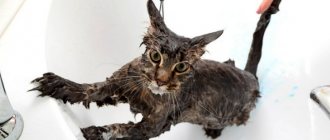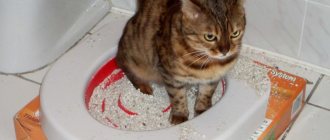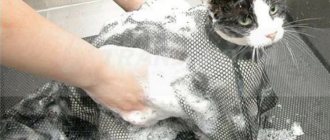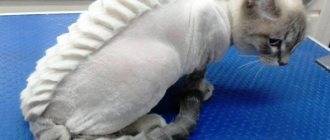At some point, cat owners need to wash their four-legged friend. And here a reasonable question arises about how to bathe a cat and “stay alive.” It is known that mustachioed and striped purrs do not like water procedures, and some of them simply cannot stand them. When washing, even the most affectionate pet sometimes turns into an angry predator that can seriously scratch you. By nature, cats are very cautious and will never get into the water unless absolutely necessary. How to bathe a cat if it gets dirty? How to reduce the unpleasant experience of the process so that the cat does not worry? This article answers these and other questions.
Is it necessary to do this at all?
Some owners argue as follows: since cats themselves are very clean, it is not at all necessary to subject them to the enormous stress that is bathing at home. This opinion is wrong. How to properly bathe a cat can only be learned by approaching this issue with all responsibility. It must be said that it is necessary to wash cats for the reason that dust and dirt gradually accumulate on their fur, which cannot be cleaned out with a rough tongue. Cats are real clean people, and therefore they will lick themselves endlessly, trying at all costs to get rid of any dirt. This excessive littering can lead to a large accumulation of cat hair in the stomach and cause a number of diseases.
You should wash your cat no more than once or twice every six months. Of course, a lot will depend on what kind of coat she has. If a cat wears a luxurious fur coat, then he will have to be bathed more often. Grooming is especially necessary for show animals before important events. In other cases, you need to wash your purr as needed.
Why bathe a cat, what is needed, how often?
In the meantime, let's discuss the question of why to bathe a cat and in what cases it should be done. If your furry friend takes regular walks outside, the answer to the question about the need to wash dirty fur is obvious.
Naturally, during the process of walking, the pet’s body becomes covered with dust and other contaminants. It is unacceptable to leave this problem unattended! Dirty fur is a suitable breeding ground for fleas, ticks and other parasites.
But, even if your cat does not go out for walks, bath procedures will still have to be carried out. Even in the cleanest house there are particles of dust that enter the living space from the street through windows, vents, clothes and shoes. You also need to take into account the polluted environment, the large volume of exhaust gases on the streets and other unfavorable factors entering the oxygen. All this settles on the animal’s fur and must be removed by washing.
When to accustom a cat to water procedures?
How to bathe a cat? It is extremely important to “introduce” a cat to the bathroom at a young age. There is an opinion that if the kitten is not accustomed to regular washing in time, then later you will not be able to do this. Representatives of the cat breed are very sensitive to their habits, so you need to make sure that they are formed in advance. The little kitten will look to you for protection, and most likely will perceive washing as something inevitable. An adult animal will definitely release its claws in the event of such an unforeseen circumstance and may inadvertently inflict deep scratches on the owner.
How often should kittens be washed?
Many owners are wondering at what time in the house it is possible to use this procedure. The kitten can be washed for the first time no earlier than 3 weeks after it arrives in the house. By this time, he will adapt to his new place of residence and get used to his owner. If a street kitten is taken into the house, then it must be washed without waiting for three weeks of adaptation. It is better to start bathing kittens no earlier than the first 3 months of life.
Kittens get dirty quite often, they do not go to the litter box as neatly as an adult pet, they are attracted to the flower pot, and this is normal, babies are less neat than cats. Sometimes they have to be washed several times a month.
When the pet is adapted to the house and does not get dirty too often, then washing should not exceed 2 times a month, since too frequent water procedures can dry out the skin and upset the fat balance. Sometimes this makes you vulnerable to various types of infections.
Bathing scheme suggested by veterinarians
Many veterinarians recommend to caring owners the following diagram to help them figure out how long to bathe their baby:
- A one-month-old cat needs to be bathed once a month.
- Four-month old – 2 times.
They also recommend washing associated with different seasons:
- In winter, it is recommended to wash your pet once, for example, in January.
- In spring - 2 times, for example, in March and mid-May.
- In summer - 2 times, for example, at the end of June and in August.
- In autumn - 1 time, for example, in October.
Of course, you can choose the time of washing at your own discretion, but this scheme is most adapted to the needs of the cat.
How to behave while swimming?
Try to calm your pet before washing. Say kind words to him (cats are very good at picking up and perceiving a person’s intonation and feeling his mood), pet him, repeat that this is a necessary procedure because he has gotten dirty. It would be a misconception to believe that cats are not capable of deep feelings for their owner. Almost always, these cute fluffies are so attuned to a person that they are able to have a beneficial effect on him.
During the process itself, hold the animal firmly, but not too tightly, with one hand, and carry out the washing procedure directly with the other. How to bathe a cat without consequences? First of all, you must be confident in yourself. Calm your pet if the situation requires it, and, if possible, try to perform all the necessary manipulations as soon as possible. Not a single cat will tolerate such “mockery” for long. It’s better to keep it to 5-10 minutes; you don’t need to count on more.
What mistakes should you avoid when taking your first bath?
The first bath lays the pet's attitude towards this event for the rest of its life. It is important to conduct it with the greatest comfort for the kitten and the least damage to its psyche.
My cat was not at all afraid of water, on the contrary, he often kept me company while taking a bath. He stood on his hind legs, put his front legs on the edge and watched, sometimes touching the soap bubbles and purring. One day, out of curiosity, he jumped onto the side and... slipped into the water. The cat's psyche could not bear such stress - since then he categorically refused to bathe.
To ensure everything goes smoothly, there are some simple rules:
- Loud conversations, sudden movements, and the sound of water will scare the baby. Talk to him kindly, in a low voice, stroke him and call him by name.
- A bathtub is not the best option for bathing. Use small containers: sink, basin.
- Place a rubber mat or towel on the bottom to prevent your baby's paws from slipping. This way he will feel more confident.
- A kitten’s body temperature is higher than that of a human; a comfortable water temperature for it is 38–400C.
- The room should be warm so that the baby does not catch a cold.
- Close the door to the room where you will perform the procedure. This will help avoid drafts, and the animal will not be able to escape if it accidentally slips out of your hands.
- Avoid getting water in your ears, as this can lead to otitis media. It is better not to wet your head during your first bath.
- Rinse off the shampoo thoroughly so that the animal does not get poisoned by licking itself after bathing.
- After bathing, wrap your baby in a towel and hold for at least 10 minutes to absorb water from the fur.
Having mastered the theoretical part, you can move on to practice.
Bath accessories
Before washing, do not forget to prepare everything you need so that your cat does not get scared. Remember: it will not stay in the water for long, so it is extremely important that you have everything at hand. How to bathe a cat and what should be prepared? Shampoo (it should already be on the table next to the bathroom), a soft brush for combing the coat, a special towel for drying, perhaps a small basin or bath.
Many cat owners prefer to wash their pets in small containers, believing that this way they will experience less stress. In fact, a lot depends on your mood. There is no need to buy a baby bathtub. How to bathe a cat if he stubbornly refuses to stand in the container prepared for him? Act gently, be patient and affectionate.
Use of special devices
Pet stores sell mesh bags for bathing cats.
The animal is placed in this bag, the headband is fastened around the pet's neck. The device will help pacify your pet: he will not scratch or try to get out of the water.
Large mesh cells do not prevent the penetration of water and detergents into the wool, and bathing will take place without problems. The owner will have both hands free, he can easily soap the pet and rinse off the detergent.
Water temperature
When preparing a bath for your pet, there are several factors to consider. Firstly, the water should not be too hot, otherwise you risk causing your pet burns of varying degrees of intensity. You should not dip your cat in cold water - he may catch a cold and get sick.
How to bathe a cat without any special consequences for it? Place your pet in the water carefully, trying not to scare it. Make sure that water does not get into the ears. It is not necessary to wash the hair, just wet the rest of the hair and gently rinse it with a special shampoo.
How to dry an animal
It is necessary to ensure that the air from the hair dryer is not too hot
To do this, it is better to take several old cotton sheets, although it is better to take your pet out of the bathroom in a terry towel, holding it tightly to you. By blotting the cat one by one with the sheets, you can easily and quickly collect excess moisture from it. You can complete the procedure with a hairdryer if the animal does not object.
For sensitive tailed individuals, a soft bath towel is offered as an alternative. The cat should be wrapped like a baby and lulled to sleep for a short time in your arms or in a warm corner of the sofa. After a nap in warmth and comfort, he will emerge from the towel semi-dry and relatively happy, but it may take two days for him to dry completely.
If the cat scratches and bites
In the event that an animal shows aggression, there is no need to worry while washing, pet it and say a few kind words. In general, it is advisable to start the procedure itself with this. Understand that the animal needs your support. It is known that cats, to put it mildly, do not like to wash themselves, so sometimes they need to be “persuaded” for a long time. If you keep your cat in the bath too long and he starts biting your hand, it's most likely your fault. Not a single representative of the cat breed will calmly stay in the water for half an hour to forty minutes, so keep in mind that time is limited.
If your pet behaves too aggressively (scratches a lot, deliberately bites your fingers, hisses threateningly), it means that its patience limit has been exhausted for today. What to do in this case? This situation occurs extremely rarely, which is why it is dangerous. If this happens, and you can’t do anything to calm the angry animal, then just let it go. Get him out of the bathroom and give him time to calm down. Most often, such precedents occur due to the fault of the owners, who force the animal to stay in the bathroom for a long time. The same case will occur if you pick up a stray cat on the street and try to wash it. After an unsuccessful attempt, take time to analyze the current situation and realize your mistake. Now you will take a more responsible approach to the question of how to bathe your cat.
What to do if your cat is afraid of water
If you have a small kitten in your home, teach him to bathe from an early age. During the first two months of life, it is not at all necessary to place the animal in a bowl of water; such a procedure can cause serious stress. The only exception can be a flea-ridden kitten picked up from the street.
The best age for the first bath of a purebred domestic cat is 3 months. You need to get used to water gradually so as not to scare the baby too much. You can start preparing for bath procedures in advance:
- from the first month of life, bring your pet into the bathroom and simply turn on the water, which will allow him to get used to the sound of flowing water;
- periodically place it in an empty basin or in a dry bath;
- This procedure should be repeated until the cat gets used to this space and stops trying to get out of the bathroom;
- To consolidate the positive result, reward the cat with a tasty treat.
Small kittens get used to bathing procedures faster, so it is very important to start bathing your pet for the first time in the early months of life. If you get an adult cat that is completely unaccustomed to bathing, you will have to make every effort and patience to accustom her to this unpleasant procedure. In this case, you should proceed step by step:
- close the door to the bathroom, eliminating the possibility of escape;
- it is better for the owner to wear a jacket with long, tight sleeves, which will avoid severe trauma to the limbs (bites, scratches);
- do not turn on the water in the presence of the cat, fill a bowl with some water in advance;
- It is better to immerse an animal in water with an assistant; it is much easier to deal with a frightened cat together;
- do not shout or show aggression, this may frighten the pet even more;
- try to encourage the cat with kind words and stroking the fur, this will allow him to calm down a little;
- so, gradually accustom him to water, starting with the slightest wetting of the fur;
- Over time, the cat will get used to the bath procedure and will react more calmly to such “care” from its owner;
- After the bath, be sure to treat your furry friend to his favorite treat!
Take care of your eyes
I mean your own. An angry animal can inadvertently hurt you. Do not bring your face closer to the cat, because at any moment it can make an uncontrolled movement that can cause serious wounds. It is clear that the question of how to bathe a cat is very difficult.
If he is terribly afraid of water, try pouring water into a container first, and only then placing the animal there. The cat may be frightened by the sound of running water, so do not turn it on additionally. If you have a long-haired pet, you should comb it thoroughly before bathing.
Types of cat shampoos
You can only wash your cat using shampoo specifically designed for this purpose.
Pet stores offer a fairly wide selection of products, and many owners are simply lost, what to choose? When choosing a shampoo, you should take into account the breed of your pet, the condition of its coat and other factors. All cat bathing products can be divided into the following main categories:
- Powder shampoo is a dry powder that is great for animals that are terrified of water. Owners of long-haired pets can periodically use this product for preventive purposes to maintain a well-groomed appearance for their pet. Powder shampoos are especially helpful before shows, when you need to quickly get your cat in order.
- Spray is an innovative product similar in effect to dry shampoos. The spray is also sprayed onto dry hair and then combed out. This product copes well with dirt, removes grease, adds shine and has a pronounced antistatic effect.
- Traditional cat shampoos are rightly considered the most effective detergent. They facilitate the combing process and allow you to get rid of the most severe dirt, which other analogues are powerless to combat. In addition, the market offers shampoos intended for cats of various breeds, products with an anti-flea effect, and a line of antiparasitic products.
Thus, each owner can choose the best shampoo option for their pet, especially since this type of product is presented in different price categories.
Also watch the video on how to wash a cat:
How to bathe a cat that has never been washed
Of course, circumstances in life can be different: you found a stray animal on the street or you simply never washed your cat for one reason or another. The first thing you should prepare for is that a cat can be stubborn for a long time and refuse to wet its lovely paws. It is better not to turn the washing procedure into violence against the animal, but to try to lure him into the bathroom: to make him go there voluntarily. If necessary, you will have to resort to various tricks and tricks. For example, you can turn on the water in the bathroom and try to attract his attention. Despite their dislike for the water element, many cats watch the flowing streams for a long time and with great interest.
How to bathe a cat? Proper bathing, of course, begins with careful preparation. If you still managed to interest the capricious purr, get ready to act gradually. Do not try to immediately pick up the animal in your arms and plunge it into the water, this will only cause a strong attack of resistance in it. To avoid such a protest when the cat enters the bathroom, let him for a while just watch how the water flows freely and easily. You can even draw his attention to the fact that there is a calm, friendly atmosphere around, and no one is going to offend the cat. How to do it? Just talk to the animal in a gentle voice, pet it. At some point you will feel that your pet has entrusted you with his own washing, and then try to carefully but quickly do everything necessary. While bathing, continue to stroke and soothe your pet.
When to bathe a cat?
It is worth noting that the procedure for putting a cat in order differs from water manipulations carried out with dogs. This is due to the fact that they have different coats, as well as different walking procedures and mechanisms. If a dog walks outside several times a day, many cats spend almost most of their time at home. If your pet is like this, then there is no point in bathing it very often. When is it necessary to bathe cats?
Indications for swimming:
- First of all, you need to pay attention to the smell. If it is strong, the cat is in heat, or the cat at home often marks the territory, then we advise you to bathe your pet in this case.
- If you notice parasites on the surface of the fur. That is, the cat has fleas.
- And the third option is preventive. That is, from time to time, even if your cat does not walk outside, he needs to be washed.
Bathing a cat
Alternative option
If it is not possible to bathe your cat at the moment, there is another way to make him clean - dry washing. Today you can find special dry shampoos in pet stores and animal departments. The essence of this “washing” is that the owner does not need to subject his pet to an unpleasant procedure. All that is required is to apply a small amount of product to the fur and comb your pet thoroughly. This option is only suitable for those who have short-haired cats.
Thus, a caring owner should approach bathing a cat with all responsibility. It is necessary to understand that the condition of the animal largely depends on your behavior, and there is absolutely no need to make him once again nervous and anxious.
When swimming is contraindicated
As you know, cleanliness is the key to health. But there are times when water treatments need to be postponed.
- First of all, focus on the animal’s well-being; if the kitten is sick, you cannot wash it.
- Unhealed wounds on the skin are another reason to postpone the procedure.
- After vaccination, the animal cannot be bathed for two weeks, after castration - for 10 days.
- Age under four weeks is a relative contraindication.
- If a kitten did not come into your home from the street, you can bathe it only after three weeks of adaptation.
- But for shingles, bath procedures are welcome.
If you carry out the first procedure carefully, without damaging the delicate mental organization of your pet, subsequently bathing will not cause negative emotions in him. And perhaps he will even love to swim. And then keeping your pet clean will not be a problem for you.
Ready-made feed
The basic rule when feeding a 2-month-old kitten with ready-made food is to never mix dry and wet food. They will be digested by the body at different times, and it will be difficult for it to rebuild
If you have been using one type of food for a long time and want to switch to another, you need to do this carefully. Over the course of 8-10 days, gradually accustom your pet to a different type of preparation, introducing it into the diet in small portions and monitoring the reaction of the ward. If you still combine 2 types of food, then 75% of the daily diet should be dry, and 25% wet
If you still combine 2 types of food, then 75% of the daily diet should be dry, and 25% wet.
pros
- High-quality food contains the optimal amount of healthy vitamins and minerals, no need to buy additional supplements.
- The composition is selected taking into account the age and physiological characteristics of the pet.
- The kitten will have to chew dry food, which will stimulate excellent jaw function.
- Saves time and effort on cooking.
- Convenient and easy to use. You can take the food with you on a trip.
- The daily dosage of food is indicated on the packaging.
Minuses
- Low-quality economy-class food is dangerous for animals due to its high content of mineral salts, the accumulation of which in the body leads to urolithiasis. In their production, production waste (animal fat, feathers, skin, etc.) is used, which clog the food tract. You will have to buy expensive food.
- Presence of fats, flavors and preservatives.
- Feed consumption is addictive. If necessary, it will be possible to wean a kitten off it only through a hunger strike.
Recommendations from veterinarians
If you decide to use ready-made food in your diet, but don’t know what to feed your 2-month-old kitten, your veterinarian’s advice will help you.
Professional breeders and veterinarians recommend buying ready-made food only in specialized stores or veterinary pharmacies. This should be premium and super-premium food, which contains all the nutrients that support life. The best ready-made dry food is considered to be holistic, the production technology of which preserves the juiciness and freshness of almost unprocessed meat, as well as the maximum benefit of the ingredients. The composition is detailed on the packages. And most importantly, such food marked “NaturCroq” is suitable for human consumption.
If we talk about specific foods for kittens, breeders often recommend the following brands:
Happy Cat Junior
Super premium dry food in the holistic category, specially designed for small kittens with sensitive stomachs from 5 weeks to 12 months
What's good:
- the composition includes the most healthy meat ingredients (beef, poultry, rabbit), as well as eggs and salmon;
- the texture and size of the food are selected in accordance with the kitten’s ability to cope with it;
1st Choice
Super-premium dry food (close in quality to holistic food) for babies from 2 to 12 months
What's good:
- excellent quality;
- affordable price for the level;
- a balanced selection of large quantities of meat and small quantities of plant ingredients;
- hypoallergenic;
- a nice addition is the inclusion of salmon fat (to improve brain activity, maintain heart and eye health).
Minuses:
- rarely found in stores, you need to place an online order on the Internet;
- Only 1 type has been developed.
Is it possible to wash a kitten with laundry soap?
The most natural soap is considered to be laundry soap. It is valued for its good cleaning ability. But it is wrong to believe that it is suitable for bathing kittens.
Common people believe that they can wash cats with laundry soap. It’s better not to do this, but to choose a less aggressive one, with a low alkali content or a neutral PH level.
If there is no special shampoo and the kitten needs to be washed, a solution of laundry soap will do. It is suitable as an emergency measure. The cat may develop dandruff and itchy skin after a bath. Some cats experience hair loss, and allergic reactions are possible.
Laundry soap 72% from the era of socialism for a pet is a kind of poison. It is important to rinse the wool well so that the pet is not poisoned by soap components.
If you find problems after washing with laundry soap, you should immediately contact a veterinarian. He will tell you how to minimize the effects of alkaline attack on the skin.
How to care for a kitten: hygiene issues
By taking a kitten home, you automatically take responsibility for its cleanliness, which, as we know, is the key to health. Usually this function is performed by the mother cat, carefully licking her baby. But a person can cope with this task even better, and the language is useful only for communicating with an animal.
Teeth cleaning
Cats have problems with their teeth and gums, which can cause diseases of the gastrointestinal tract, skin and other systems. Brushing your teeth significantly reduces the risk of such problems. But it is necessary to accustom a cat to brushing its teeth at a very early age, so if you have a three-month-old kitten for permanent residence, brush its teeth. Toothpastes with the smell and taste of fish or meat, and a special toothbrush will help you with this - the kitten will not resist much, and after several procedures, he may even begin to like this process. You can brush your teeth once a month.
Video: Tips for brushing your cat's teeth
Nail trimming
There are special scissors for cutting cat claws, but manicure nail clippers, which are found in almost every home, are also suitable. The time to trim your nails is when their sharpness begins to cause you discomfort. It is also better to accustom an animal to this procedure from childhood, performing it once every two weeks. How far can you trim your claws? In cats with white scratches, you will be able to see the pink core in the claw - you cannot touch it, it is living tissue, so you can trim it down to it. In cats with black claws, the core is not visible and the claw is cut to a length of a millimeter and a half - this is usually enough for the animal to stop scratching too much during games.
Video: trimming claws
Ear cleaning
A cat's ears can harbor ear mites. To avoid this, you need to clean your ears once a month. If necessary, it can be done more often. The procedure is quite simple - you can moisten a swab with a cotton swab a little in peroxide (or pre-drip your ears with special drops) and gently wipe the auricle. You also need to wipe inside the ear, plunging the stick as deep as the structure of the ear allows, without much effort. Cats react to this differently, so if the animal expresses dissatisfaction, this is normal. The main thing is not to overdo it.
Video: Clean cat ears
The coat is combed once or twice a week, depending on the furiness of the kitten. As already noted, you can use any brushes that do not cause discomfort to the animal during the process. Many animals approve of hand brushes.
How to wash a cat if there is no special shampoo
For regular care of animals, special products are needed. They are less aggressive in composition than regular shampoos. It is best to wash the cat with warm water and beaten egg yolk. If that doesn’t work, you need compounds with PVA.
In rare cases, you can wash cats with regular shampoo or soap, but it is not advisable to do this often. The animal's skin will begin to peel off.
Let's discuss what to choose from what is in the bathroom.
Regular soap
It is not recommended to bathe a kitten with soap with a strong fruity or floral aroma. Bath, pine, and baby soap are preferable. Experienced veterinarians do not advise excessive soaping of the animal.
It is enough to pour it with soapy water or apply foam to the wool. If the surfactants (surfactants) don't touch the skin, great.
You shouldn't bathe your pet too hard. He must have natural protection.
Baby shampoo
Products used to wash children under three years of age are hypoallergenic. They contain less of all kinds of synthetic additives and more natural ingredients. But you can’t get carried away with them either.
The product is pre-diluted 1:3 and foamed well. And then the kitten is treated with foam. You need to carefully clean the face.
Phrases like “washes without tears” are a marketing ploy. When foam gets into the eyes of animals, conjunctivitis develops. The small pet will become restless. Ears are a no-go area. They are cleaned with ear sticks with water, lotion or saline solution.
Regular human shampoo
Some owners use human shampoo to care for their pets, and do this regularly. Veterinarians strictly prohibit doing this. The secretion of fatty glands is disrupted, the skin suffers, and the structure of the hairs changes.
Allergic dermatitis and other skin diseases are possible. Immunity weakens. After washing, cats get sick more often and can get pneumonia.
If there are several hair care products, choose the simplest one. It is better if it contains a decoction of herbs, without dyes or thickeners.
The soap composition is made by diluting the shampoo with water, increasing the volume at least five times. In this case, it will be possible to protect the cat from the consequences and reduce the risk of developing skin diseases.
Tar shampoo or liquid soap
Tar is an excellent folk remedy for skin irritation. Liquid soap or tar shampoo is a good insecticidal remedy for blood-sucking insects.
If your pet constantly scratches itself with its paws or bites something out of its fur, it may have fleas. Try washing it with tar soap. This primitive method is used in folk medicine.











